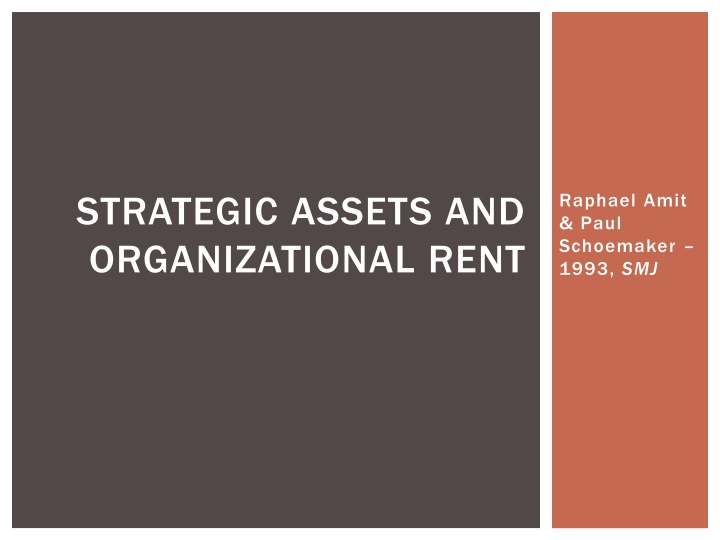
Strategic Assets and Organizational Rent in Business Management
Explore conditions leading to sustainable economic rents, with insights into asymmetry in firm knowledge and resources, industry analysis frameworks, behavioral biases, and strategic asset management. Delve into decision-making processes, resource-based views, and key success factors in industries.
Download Presentation

Please find below an Image/Link to download the presentation.
The content on the website is provided AS IS for your information and personal use only. It may not be sold, licensed, or shared on other websites without obtaining consent from the author. If you encounter any issues during the download, it is possible that the publisher has removed the file from their server.
You are allowed to download the files provided on this website for personal or commercial use, subject to the condition that they are used lawfully. All files are the property of their respective owners.
The content on the website is provided AS IS for your information and personal use only. It may not be sold, licensed, or shared on other websites without obtaining consent from the author.
E N D
Presentation Transcript
STRATEGIC ASSETS AND ORGANIZATIONAL RENT Raphael Amit & Paul Schoemaker 1993, SMJ
ARTICLE OVERVIEW Conditions that lead to sustainable economic rents Conditions that lead to sustainable economic rents Asymmetry between firm knowledge / resources Examine links between Examine links between Industry analysis framework Industry analysis framework Resource Resource- -based view based view Behavioral decision biases Behavioral decision biases Organizational implementation issues Organizational implementation issues Connect the concept of Strategic Industry Factors at the Connect the concept of Strategic Industry Factors at the market level with the notion of Strategic Assets at the firm market level with the notion of Strategic Assets at the firm level. level.
EXPLAINING DECISION MAKING 1.0 Firm Firm- -specific resources and capabilities are used to explain a specific resources and capabilities are used to explain a firm s performance (uniqueness, customer firm s performance (uniqueness, customer- -base, profits, etc.) base, profits, etc.) Ex ante Ex ante decisions characterized by decisions characterized by Uncertainty Uncertainty Environment Environment Competitor s behavior Competitor s behavior Customer preferences Customer preferences Complexity Complexity Environments & perceptions Environments & perceptions Intra Intra- -organizational conflicts organizational conflicts Amongst managers / departments or divisions Amongst managers / departments or divisions Difficult to model / articulate But clearly more than just firm- side resources & capabilities
RESOURCE BASED VIEW FIRM INDUSTRY ? Resources: - externally available & transferable - owned / controlled by firm - convertible Capabilities: - information based - firm specific - tangible or intangible - intermediate goods Strategic Assets
INDUSTRY VIEW Key Success Factors Key Success Factors ( (Vasconcellos By product of empirical, By product of empirical, ex post it depends on matching strengths with its environment it depends on matching strengths with its environment Firms with the highest KSF outperform their rivals Firms with the highest KSF outperform their rivals , 1989) - - Vasconcellos and ex posttest of an organization s success as test of an organization s success as and Hambrick Hambrick, 1989) KSF Limitations KSF Limitations Considers industry as primary unit of analysis, where decisions are Considers industry as primary unit of analysis, where decisions are made my managers from a firm perspective made my managers from a firm perspective Looks at everything Looks at everything ex post ex post, whereas decisions are made , whereas decisions are made ex ante KSF are relative between firms (i.e. they all can t score well) KSF are relative between firms (i.e. they all can t score well) ex ante
INDUSTRY VIEW Strategic Industry Factors Strategic Industry Factors Resources and capabilities which are dependant on market Resources and capabilities which are dependant on market failures failures Characterized by their proneness to market failures and Characterized by their proneness to market failures and asymmetric distributions across firms asymmetric distributions across firms Determined at the market level through interactions between Determined at the market level through interactions between competitors, customers, regulators, innovators, etc. competitors, customers, regulators, innovators, etc. Allows for Allows for ex ante ex ante explanations for decision making explanations for decision making
FIRM AND INDUSTRY CONSTRUCTS FIRM INDUSTRY Substitutes Customers Resources: - externally available & transferable - owned / controlled by firm - convertible Capabilities: - information based - firm specific - tangible or intangible - intermediate goods Strategic Industry Factors: - industry specific - affect industry profitability - change & subject to ex ante uncertainty Rivals Entrants Strategic Assets Environmental Factors Suppliers
EXPLAINING DECISION MAKING 2.0 Managers must identify strategic assets (resources and Managers must identify strategic assets (resources and capabilities) in order to generate sustainable advantage and capabilities) in order to generate sustainable advantage and organizational rents organizational rents This involves identifying strategic industry factors for the present This involves identifying strategic industry factors for the present and future and future But what about Behavioral Decision Theory? But what about Behavioral Decision Theory?
BEHAVIORAL DECISION THEORY Managers must (subjectively / with bias) Anticipate possible futures Assess competitive interactions Overcome organizational inertia BDT builds on the resource based view by acknowledging BDT builds on the resource based view by acknowledging bounded rationality and differences in problem framing (or bounded rationality and differences in problem framing (or variable rationality ) when dealing with variable rationality ) when dealing with Uncertainty Uncertainty Complexity Complexity Conflict Conflict
EXPLAINING DECISION MAKING 3.0 Standard Strategic Assets theory fails to systematically lead to Standard Strategic Assets theory fails to systematically lead to the creation of sustainable rents due to industry pressures the creation of sustainable rents due to industry pressures Strategic Industry Factors allow for a multidimensional view to Strategic Industry Factors allow for a multidimensional view to making decisions making decisions Industry analysis Industry analysis Resource perspective Resource perspective Behavioral decision theory Behavioral decision theory This, in turn, allows for the development of resources and This, in turn, allows for the development of resources and capabilities into sustainable organizational rents by taking capabilities into sustainable organizational rents by taking market & knowledge imperfections and management subjectivity market & knowledge imperfections and management subjectivity into account into account






















